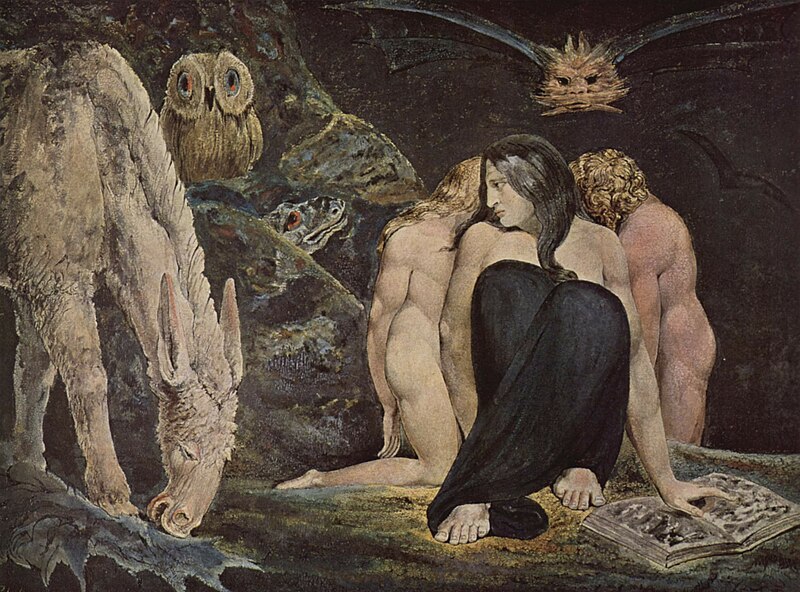Blake's picture which goes both by the names Hecate and The Night of Enitharmon's Joy is one of his Large Color Printed Drawings of 1795. There are reasons why the picture came to be called by different names. Blake would have been familiar with Hecate's role in ancient mythology and with the instances in which she appears in Shakespeare's Macbeth and Midsummer Night's Dream. The central figure is pictured threefold as the goddess Hecate was imagined by the Greeks, but for Blake she includes a young male and a young female with the central woman. She is beautiful as Blake said the the witches in Shakespeare should be represented.
Descriptive Catalogue, (E 535)
"By way of illustration, I instance Shakspeare's Witches in
Macbeth. Those who dress them for the stage, consider
them as wretched old women, and not is as Shakspeare intended, the
Goddesses of Destiny; this shews how Chaucer has been
misunderstood in his sublime work. Shakspeare's Fairies also
are the rulers of the vegetable world, and so are Chaucer's;
let them be so considered, and then the poet will be understood,
and not else."
She is
accompanied by the bat, the snake and the owl which are associated
with Hecate as a goddess of the night and the underworld. Since
the donkey is not generally associated with Hecate its presence is
a reference to Titania, Queen of the fairies, who in Midsummer
Night's Dream under a spell, falls in love with a man with
the appearance of a donkey. This reference would indicate the
foolishness of the male submitting to female dominance.The phrase Enitharmon's Joy comes from the poem Europe which speaks of the rise of Orc or revolution. Preliminary to the outbreak of Orc's conflagration is the night of Enitharmon's Joy, the dominance of woman or female love which results from the idea that loving a woman is sinful, that heaven comes after death and that joy is forbidden. After being under female dominion for Eighteen Hundred Years the active energy of the male breaks out of the webs and nets which have bound him.
Europe, Plate 4 , (E 62)
"The horrent Demon rose, surrounded with red stars of fire,
Whirling about in furious circles round the immortal fiend.
Then Enitharmon down descended into his red light,
And thus her voice rose to her children, the distant heavens reply.
Plate 5
Now comes the night of Enitharmons joy!
Who shall I call? Who shall I send?
That Woman, lovely Woman! may have dominion?
Arise O Rintrah thee I call! & Palamabron thee!
Go! tell the human race that Womans love is Sin!
That an Eternal life awaits the worms of sixty winters
In an allegorical abode where existence hath never come:
Forbid all joy, & from her childhood shall the little female
Spread nets in every secret path.
My weary eyelids draw towards the evening, my bliss is yet but new."
Milton Klonsky in William Blake, The Seer and His Visions comments on Hecate
on page 60:"Both Hecate and Pity ... were meant to illustrate dual aspects of what Blake regarded as the domineering Female Will, which attempts to ensnare the a male in a web of religion woven out of sexual repression, chastity and jealousy. 'O Woman-born/ And Woman-nourish'd & Woman-educated & Woman-scorn'd' he wrote in Jerusalem (64:16-17)."
Jerusalem, Plate 30 [34], (E 176)
"I hear the screeh of Childbirth loud pealing, & the groans
Of Death, in Albions clouds dreadful utterd over all the Earth
What may Man be? who can tell! but what may Woman be?
To have power over Man from Cradle to corruptible Grave.
There is a Throne in every Man,it is the Throne of God
This Woman has claimd as her own & Man is no more!
Albion is the Tabernacle of Vala & her Temple
And not the Tabernacle & Temple of the Most High
O Albion why wilt thou Create a Female Will?
To hide the most evident God in a hidden covert, even
In the shadows of a Woman & a secluded Holy Place
That we may pry after him as after a stolen treasure
Hidden among the Dead & mured up from the paths of life"


No comments:
Post a Comment